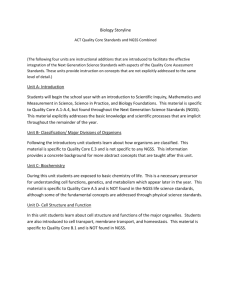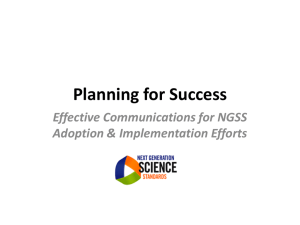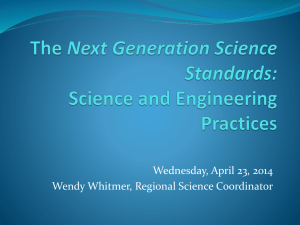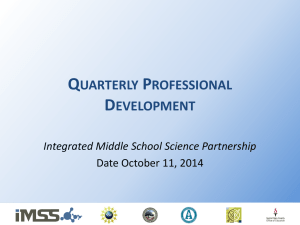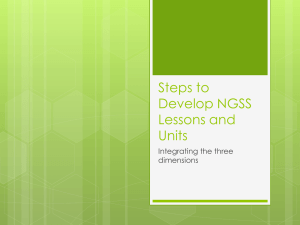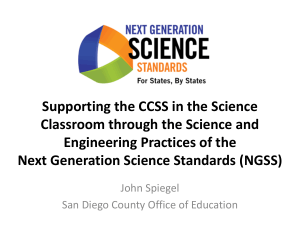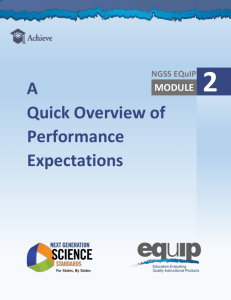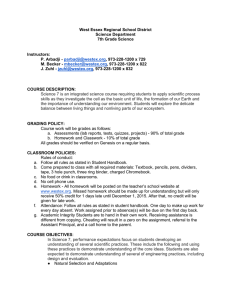ISLN
advertisement
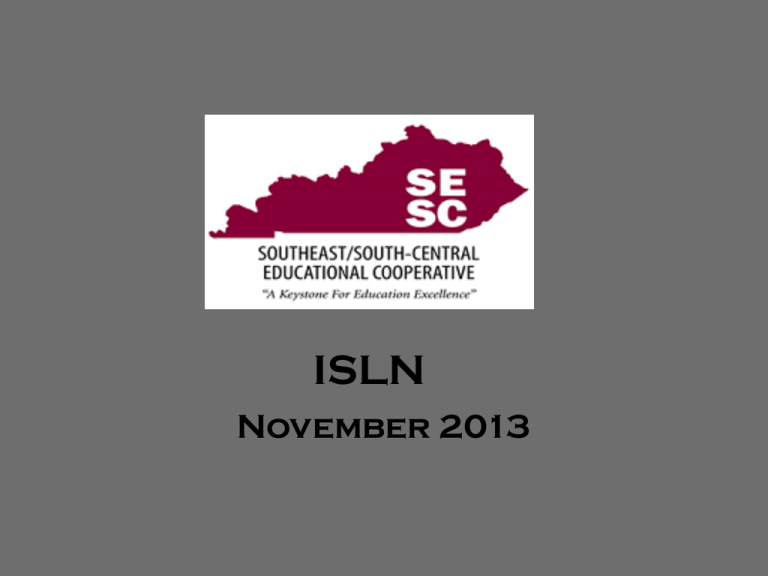
ISLN November 2013 TODAY: Quick review of the NGSS Framework Take a look at the K-12 Progression of each PE by Topic Analyze the process of creating Learning Targets from Performance Expectations Compare two science classrooms using FfT, CHETL and NGSS Quick Review of the Architecture of the Next Generation Science Standards Title Assessable Component How What Why Foundation Boxes Connection Box KCAS for Science / NGSS K - 12 Progression of each Performance Expectation by Topic TOPIC: Chemical Reactions Earth’s Systems HS O8 ESS2-2 ESS2-3 ESS2-5 ESS2-6 ESS2-7 O7 O6 5 ESS2-1 ESS2-4 ESS2-1 ESS2-2 ESS3-1 ESS3-1 Energy PS3-1 PS3-2 PS3-3 PS3-4 PS3-5 Forces and Interactions (3,6,7, &12) Forces and Interaction: Pushes and Pulls (K) PS2-1 PS2-2 PS2-3 PS2-4 PS2-5 Human Impacts Inheritance and Variation of Traits (HS) Inheritance and Variation of Traits: Life Cycles and Traits (3) Interdependent Relationships in Ecosystems The Performance Expectations have been filled in for you. PS3-1 ESS1-5 ESS1-6 ESS2-1 ESS1-4 ESS3-1 ESS3-2 ESS3-3 ESS3-4 ESS3-6 ESS3-2 ESS3-3 ESS3-4 LS1-4 LS3-2 1 PS2-1 PS2-2 LS1-4 LS1-5 ESS2-2 ESS2-3 LS1-1 LS3-1 LS3-2 LS4-2 LS2-5 LS2-1 LS4-1 LS4-3 LS4-4 LS2-2 LS2-1 LS2-2 LS4-1 LS1-1 ESS2-2 ESS3-1 ESS3-3 Interdependent Relationships in Ecosystems: Animals, Plants, & Their Environment TOPIC: O8 O7 O6 5 Matter and Energy in Organisms and Ecosystems LS1-5 LS1-6 LS1-7 LS2-3 LS2-4 LS2-5 LS2-4 LS1-6 LS1-7 LS2-1 LS2-3 PS3-1 LS1-1 LS2-1 Natural Selection and Adaptations (8) Natural Selection and Evolution (HS) LS4-1 LS4-2 LS4-3 LS4-4 LS4-5 LS4-1 LS4-2 LS4-3 LS4-4 LS4-6 Space Systems HS ESS1-1 ESS1-3 3 2 PS2-1 ESS1-1 ESS1-2 Structure and Function (HS) Structure, Function and Information Processing (1,4,7 & 8) LS1-1 LS1-2 LS1-3 Structure and Properties of Matter PS1-1 PS1-3 PS2-6 PS1-8 LS1-8 LS1-1 LS1-2 LS1-3 PS1-1 PS1-3 PS1-4 LS1-1 LS1-2 LS3-1 PS1-1 PS1-2 PS1-3 PS1-4 PS1-1 PS1-2 PS1-3 PS1-4 PS4-1 PS4-2 PS4-3 PS4-4 PS4-1 PS4-3 ESS3-5 K PS4-1 PS4-2 PS4-3 PS4-1 PS4-2 PS4-3 PS4-4 PS4-5 ESS2-4 1 ESS1-1 ESS1-2 PS4-2 LS1-1 LS1-2 Waves: Light and Sound (1) Waves: Waves and Information (4) Weather and Climate 4 ESS1-1 ESS1-2 ESS1-3 ESS1-2 ESS1-4 Space Systems: Patterns and Cycles (1) Space Systems: Stars and the Solar System (5) Waves and Electromagnetic Radiation K ESS1-1 ESS2-1 ESS2-2 ESS2-3 PS2-1 PS2-2 PS2-3 PS2-4 PS2-1 PS2-2 LS3-1 LS3-3 LS2-1 LS2-2 LS2-6 LS2-7 LS2-8 LS4-6 2 PS3-1 PS3-2 PS3-3 PS3-4 ESS3-1 PS3-2 PS3-3 PS3-4 PS3-5 PS2-3 PS2-4 PS2-5 LS3-1 LS3-2 LS4-5 Growth, Development, and Reproduction of Organisms History of Earth 3 ESS1-1 ESS2-1 ESS2-2 ESS3-2 Earth’s Systems: Processes that Shape the Earth Take a look at the K – 12 Performance Expectation Progression Matrix organized by Topics 4 PS1-2 PS1-5 PS1-6 PS1-2 PS1-4 PS1-5 PS1-6 PS1-7 ESS3-5 ESS2-5 ESS2-6 ESS2-1 ESS3-2 ESS3-1 PS3-1 PS3-2 ESS2-1 ESS3-2 Please find the handout: The Distinction between Performance Expectations and Learning Targets Performance Expectations and Learning Targets Performance Expectations Learning targets - Written as statements describing student performances that can be assessed - Smaller and more focused statements for students that build toward mastery of a Performance Expectation - Extremely broad goals and represent true standards to be achieved - Manageable “student friendly” segments for the purpose of planning instruction - Require several skills and concepts - Specific concepts, knowledge and skills that are the foundation of a larger more complex standard Turn your handout over and lets take a look at the PROCESS of Deconstructing a Performance Expectation Can you simply add the words “I CAN” to this broad and complex statement? NO WAY! To understand Performance Expectations the teacher and students need to DECONSTRUCT the standards into Learning Targets The Three Columns for Deconstructing a Performance Expectation: K – PS2 - 2 Analyze data to determine if a design solution works as intended to change the speed or direction of an object with a push or a pull. Identify the key parts and words… Analyze data to determine if a design solution works as intended to change the speed or direction of an object with a push or a pull. Knowledge: Reasoning or Performance Skill: Product: Describe pushes/pulls as forces that move an object. Describe the relationship between the strength of the push or pull and the change in speed or direction. None Know that speed is how fast something moves. Identify change as a difference in something. Recognize that “data” is collected information. Infer that people can cause change in an object’s speed or direction. Interpret speed/direction data to support a claim that the design solution worked or not. Performance Expectations contrast the smaller more focused nature of student learning targets Performance Expectations contrast the smaller more focused nature of student learning targets Teachers can work with students on this process Performance Expectations contrast the smaller more focused nature of student learning targets Teachers can work with students on this process Giving the students ownership and understanding that learning targets are the building blocks of something bigger allows for a much clearer path to learning Creating Student Friendly Learning Targets is a First Step in Developing Curriculum, Instruction and Assessment for NGSS TIME TO WRITE Please locate the index card at your table Just need one card per table or District Take 5 Minutes One card per Table or District Take 5 minutes and discuss at your table On one side of the index card finish the following sentences: 1. We noticed… 2. The impact of deconstructing Performance Expectations into Learning Targets… 3. We look forward to learning more about… Find FOUR Handouts: 1. Mrs. Williams’ Class Packet 2. Criteria Handout 3. CHETL and NGSS Packet 4. Science CHETL Packet Grab a cup of water and a new index card Try the activity mentioned in the two scenarios Be careful you might make a mess http://www.youtube.com/watch?v=ibw2C9KQlTM Sharpen Your Eye http://www.youtube.com/watch?v=65T4ReLkjCg Read “Mrs. Williams Class” Scenario Read “Mr. DeLong’s Class” Scenario Which classroom most represents highly effective teaching and learning? Why? TIME TO SHARE Your table was assigned a specific box from this activity Find the correct box on the Gallery to share with the other groups Once the Gallery is full take a few minutes to see how your group compares with the other groups Concerns/Questions/Request for Support: TIME TO WRITE Please locate the index card at your table Concerns/Questions/Request for Support: On The Back of Your Index Card: How can I provide help in your District? Do you have questions, concerns or requests for support? KCAS for Science / NGSS Resources for your schools or teachers Call or email me any time: Kevin Crump 859-200-5686 kevin.crump@education.ky.gov


